
Deposition Date
2019-04-14
Release Date
2020-05-13
Last Version Date
2023-11-22
Entry Detail
PDB ID:
6JUK
Keywords:
Title:
Crystal structure of Formate dehydrogenase mutant C256I/E261P/S381I from Pseudomonas sp. 101 in complex with non-natural cofactor Nicotinamide Cytosine Dinucleotide
Biological Source:
Source Organism:
Pseudomonas sp. 101 (Taxon ID: 33067)
Host Organism:
Method Details:
Experimental Method:
Resolution:
2.29 Å
R-Value Free:
0.20
R-Value Work:
0.15
R-Value Observed:
0.16
Space Group:
P 1 21 1


